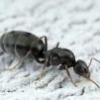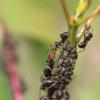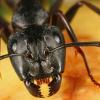i bought a few Myrmica species from https://canada-ant-colony.com/ and like always i created a bookmark of each species with link of info , picture ,care etc...
and i saw this about the Myrmica punctiventis
source of the text
https://link.springe...1007/BF00164122
it's about polydomy and sexual ......get ready
Colony structure and reproductive investment were studied in a population of Myrmica punctiventris. This species undergoes a seasonal cycle of polydomy. A colony overwinters in entirety but fractionates into two or more nest sites during the active season and then coalesces in the fall. Colony boundaries were determined by integrating data on spatial pattern, behavioral compatability, and genetic relatedness as revealed by protein electrophoresis. Colonies contained at most one queen. Consequently, a colony consisted of one queenright nest and one or more queenless nests. Furthermore, estimates of relatedness were fully consistent, with queens being single mated. M. punctiventris therefore has a colony genetic structure that conforms to the classical explanation of the maintenance of worker sterility by kin selection. Kin selection theory predicts that workers would favor a female-biased allocation ratio while selection on queens would favor equal investment in males and females. We predicted that in polydomous populations, queenless nests would rear more female reproductives from diploid larvae than queenright nests. There was a significant difference between queenright and queenless nests in sexual allocation; queenless nests allocated energy to reproductive females whereas queenright nests did not. At neither the nest nor colony levels did worker number limit sexual production. We also found that nests tended to rear either males or females but when colony reproduction was summed over nests, the sexes were more equally represented. The difference in allocation ratios between queenless and queenright nests was attributed solely to queen presence/absence. Our work shows that polydomy provides an opportunity for workers to evade queen control and thereby to sexualize brood.
















